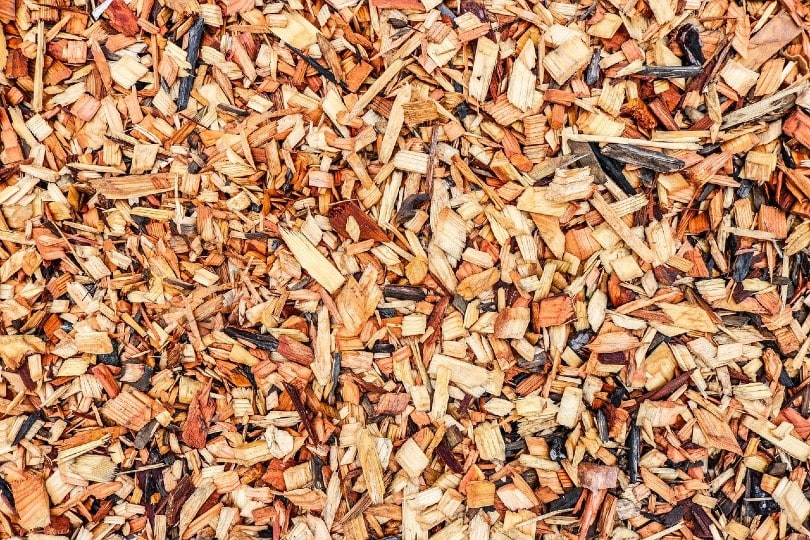Best Mulches for Garden Paths: 7 Great Options (With Pictures)
-
Chris Dinesen Rogers
- Last updated:

Mulch acts as both a landscaping element and a utilitarian function in the garden. It succeeds admirably at both. It benefits you by keeping your plants healthier and more resilient because it slows water loss. It can also keep weeds under control, assuming you put down a thick enough layer. That means less maintenance with a good-looking yard. Let’s check out some of the best options on the market.
The 7 Great Mulch Options for Garden Paths
1. Wood Chips

Wood chips are the old standby, with several sources available from which to choose. The various types bring color choices to the table. Popular options include cedar, pine, and cypress. They decompose slowly, making them a worthwhile investment. It’s worth noting that the Florida-Friendly Landscaping Program¹ discourages cypress because of unsustainable harvest concerns.
2. Shredded Bark

Shredded bark consists of many of the tree species from the above option. It’s often chunkier, meaning it’ll last longer. That makes it a better value since you may not have to replace it every year. We also liked that it’s sourced from the forest industry for the ultimate root-to-leaf sustainable use. It’ll provide an interesting contrast for stone paths.
3. Pine Straw

Pine straw is an excellent choice for garden paths in rural settings. Despite its lightweight, it forms mats that keep it in place. It doesn’t last as long as chips but will persist longer than our next pick. It will look great in an English country garden with its informal theme. You can also use it to protect fruits and vegetables.
4. Fallen Leaves

If you want to put your fallen leaves to good use, you can’t do much better with a free and seemingly endless option for a garden path. It won’t last more than a season. However, it’ll lend a natural look to your landscaping.
The other great thing about it is it’ll break down quickly, releasing nutrients into the soil to keep your lawn healthy.
5. Repurposed Pallets and Utility Wood

We love options where repurposing is among the benefits. Using old pallets is one way to get affordable mulch when you prepare it yourself with a rented chipper. You can also contact your local utility company. Many municipalities will offer scraps from tree trimming for free if you can haul them away. It’s a cheaper way to get mulch, even with the equipment’s rental fee.
6. Pea Gravel or River Rock

Pea gravel and river rock stand out as inorganic mulch sources. However, they get the job done just as well while adding a decorative element to your landscaping.
The weight of its compacted layer will provide an effective barrier against weeds. It’s more difficult to replace if you change your mind. However, you can’t argue with how beautiful it looks.
7. Living Mulch

One unique mulching option is the use of ground-cover plants like thyme. This perennial herb comes in many variations, such as lemon thyme. You’ll love the scent of the crushed plants as you walk your garden path. It does an excellent job of filling in around the stones and will help anchor the soil around them.
Mulching Tips
It’s essential to consider the lay of the land when deciding on the best choice for your yard. Some organic mulches are inappropriate choices in low-lying areas. Mulches made of wood may rot and end up causing more problems than they solve. It’s also vital to put down enough product if weed control is your goal. Often, people underestimate how much they’ll need. Hint: It’s more than you think.
We recommend using a calculator to determine how much bulk mulch or bags you need to cover the area adequately. Aim for 3 to 4 inches. Bear in mind you may need to replace it yearly if it shows signs of thinning. Remember that your mulch won’t do its job if you don’t do your bit.
While we’ve given you several choices, it’s imperative to plan your landscaping before making big decisions, like the best mulch for garden paths.
Final Thoughts
Our favorite pick for mulch for a garden path is the traditional bark chips. We like the various colors, which add a warm, natural tone to your landscaping. We love the aroma of this wood, which may help keep insect pests away. They are relatively also affordable, making it an excellent choice if you have a large area to mulch. Regardless, all of the options on this list have you covered.
Featured Image Credit: Zania Studio, Shutterstock
Contents
